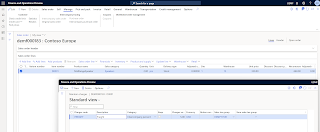Purpose: The aim of the Intercompany percent functionality is to address the scenario when the unit price on the IC sales order is used as equal to the cost price, and the vendor does not receive any profit margin. To compensate for the loss of profit margin, the vendor can add a charge to get a percentage of the Net amount from the original sales order line.
Business scenario:
The Intercompany vendor sells the items to the distribution company by using the cost price as a unit price. Instead of a margin, the vendor adds a miscellaneous charge as a percent of the unit price on the Original sales order.
Example:
The unit price on the Original sales order in DEMF is $300.00 U.S. Dollars (USD). The cost price for the item in USMF is $125.00 USD. Therefore, the sales price on the Intercompany sales order is set equal to the cost $125.00. This sales price is synchronized as the purchase price to the Intercompany purchase order in DEMF.
If a miscellaneous charge on the sales order line of the Intercompany sales order is set to Intercompany percent in the Category field, and the charge value of 10 is set up, 10 percent of the unit price of the Original sales order is added. In this example, this is 10 percent off $300.00 or $30.00.
Walkthrough:
Setting Unit price equal to cost price
- Open USMF > Sales and marketing > Customers > All customers and select an Intercompany customer.
- Select General and then Intercompany on the Action Pane.
- Select Sales order policies.
- Select the Unit price equal to cost price parameter to use the cost price instead of trade agreements or the defined sales price on the item.
- If the "Unit price equal to cost price" parameter is selected, you can select the Initiate original customer invoice posting parameter. This means that if the posting of the invoice on the Intercompany sales order is stopped because of an error, the invoice on the Original sales order is posted anyway.
Setting Auto charge for the Intercompany percent
- Go to USMF > Accounts receivable > Setup > Charges setup > Auto charges.
- Change Level to Line. Note: Intercompany percent is allowed only on intercompany sales/purchase order lines.
- Select New and fill in the required fields.
Process:
Go to DEMF > Accounts receivable > Orders > All sales orders
Create a new sales order for DE-010 customer
Create a new line for D0001 item, qty = 3 pcs, unit price = 600 euro
Select New Purchase order on the Action pane > Include > OK.
Go to the DEMF > Purchase order created and make sure that Charges have been added.
Go to the USMF > IC Sales order created and make sure that Charges have been created as well.

Note: I would like to explain what is going on with prices and how they are synchronized to the purchase order. In the presented scenario, for the intercompany customer on the Intercompany setup > Sales order policies configuration, "Price and discount search" parameter was activated. It means that when IC SO is created, the system will try to find the sales price. In this case, a valid sales trade agreement for 330 USD was found, later on this price was synchronized back to the IC PO. Since "Unit price equal to cost price" parameter is also activated, when reservation is done on the IC SO, the actual cost of the item will be identified, and unit price will be updated on the IC SO and then synchronized back to the IC PO. Keep in mind that cost identification cannot happen immediately when IC SO is created, it can happen only when inventory is reserved (manually, on through packing slip posting etc.).
In the IC SO, complete reservation and packing slip posting. Note that unit price is updated by the cost price of the item.
In the IC SO, post invoice. Once posted, check the charges.
Misc. charge amount calculated as a percent of the Net amount of the original sales order line (in company DEMF).
The Net amount of the Original order is 1200 EUR. If you calculate it in the currency of the IC SO (USD) it would be 1643.84 USD. You can use Totals page from the Original SO and by changing the currency you can identify the right amount and exact exchange rate.
So, 5 % of the 1643.84 USD is 82.19 USD.
Now, proceed with IC PO posting process: Confirm, post Product receipt and Invoice the PO.
That's it!













